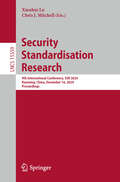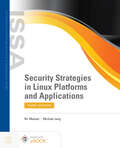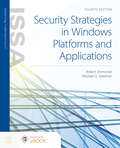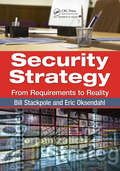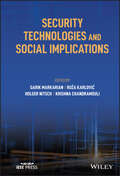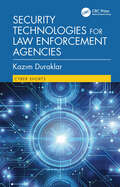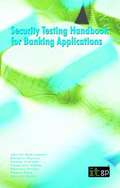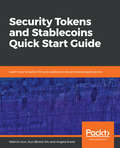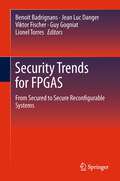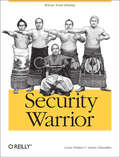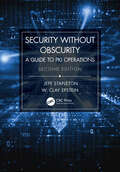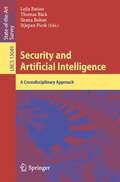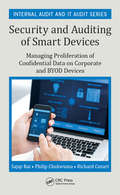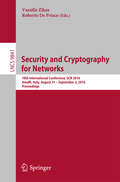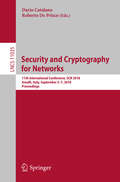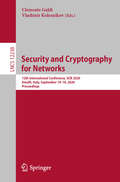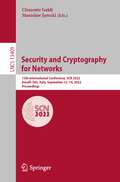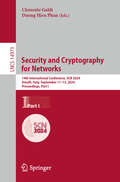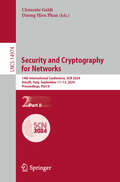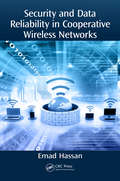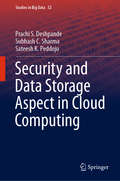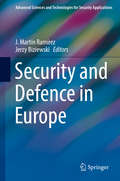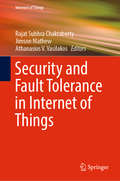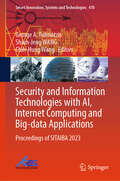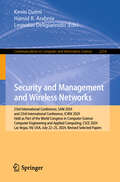- Table View
- List View
Security Standardisation Research: 9th International Conference, SSR 2024, Kunming, China, December 16, 2024, Proceedings (Lecture Notes in Computer Science #15559)
by Chris J. Mitchell Xianhui LuThis book constitutes the refereed proceedings of the 9th International Conference on Security Standardisation Research, SSR 2024, held in Kunming, China, during December 16, 2024. The 7 full papers included in this book were carefully reviewed and selected from 19 submissions. These papers focus on a wide range of topics within the field of Security standardization research. This book also includes the full paper from the invited keynote talk titled "Standardisation of and Migration to Post-Quantum Cryptography", given by Liqun Chen.
Security Strategies in Linux Platforms and Applications
by Michael Jang Ric MessierThe third edition of Security Strategies in Linux Platforms and Applications covers every major aspect of security on a Linux system. Using real-world examples and exercises, this useful resource incorporates hands-on activities to walk readers through the fundamentals of security strategies related to the Linux system. Written by an industry expert, this book is divided into three natural parts to illustrate key concepts in the field. It opens with a discussion of the risks, threats, and vulnerabilities associated with Linux as an operating system using current examples and cases. Part 2 discusses how to take advantage of the layers of security available to Linux--user and group options, filesystems, and security options for important services. The book closes with a look at the use of both open source and proprietary tools when building a layered security strategy for Linux operating system environments.
Security Strategies in Windows Platforms and Applications
by Michael G. Solomon Robert ShimonskiRevised and updated to keep pace with this ever-changing field, Security Strategies in Windows Platforms and Applications, Fourth Edition focuses on new risks, threats, and vulnerabilities associated with the Microsoft Windows operating system, placing a particular emphasis on Windows 11, and Windows Server 2022. The Fourth Edition highlights how to use tools and techniques to decrease risks arising from vulnerabilities in Microsoft Windows operating systems and applications. The book also includes a resource for readers desiring more information on Microsoft Windows OS hardening, application security, and incident management. With its accessible writing style, and step-by-step examples, this must-have resource will ensure readers are educated on the latest Windows security strategies and techniques.
Security Strategy: From Requirements to Reality
by Bill Stackpole Eric OksendahlClarifying the purpose and place of strategy in an information security program, this book explains how to select, develop, and deploy the security strategy best suited to your organization. It focuses on security strategy planning and execution to provide a comprehensive look at the structures and tools needed to build a security program that enables and enhances business processes. Divided into two parts, the first part considers business strategy and the second part details specific tactics that support the implementation of strategic planning initiatives, goals, and objectives.
Security Technologies and Social Implications
by Garik Markarian Ru A Karlovi Holger Nitsch Krishna ChandramouliB>SECURITY TECHNOLOGIES AND SOCIAL IMPLICATIONS Explains how the latest technologies can advance policing and security, identify threats, and defend citizens from crime and terrorism Security Technologies and Social Implications focuses on the development and application of new technologies that police and homeland security officers can leverage as a tool for both predictive and intelligence-led investigations. The book recommends the best practices for incorporation of these technologies into day-to-day activities by law enforcement agencies and counter-terrorism units. Practically, it addresses legal, technological, and organizational challenges (e.g. resource limitation and privacy concerns) combined with challenges related to the adoption of innovative technologies. In contrast to classic tools, modern policing and security requires the development and implementation of new technologies using AI, machine learning, social media tracking, drones, robots, GIS, computer vision, and more. As crime (and cybercrime in particular) becomes more and more sophisticated, security requires a complex mix of social measures, including prevention, detection, investigation, and prosecution. Key topics related to these developments and their implementations covered in Security Technologies and Social Implications include: New security technologies and how these technologies can be implemented in practice, plus associated social, ethical or policy issues Expertise and commentary from individuals developing and testing new technologies and individuals using the technologies within their everyday roles The latest advancements in commercial and professional law enforcement technologies and platforms Commentary on how technologies can advance humanity by making policing and security more efficient and keeping citizens safe Security Technologies and Social Implications serves as a comprehensive resource for defense personnel and law enforcement staff, practical security engineers, and trainee staff in security and police colleges to understand the latest security technologies, with a critical look at their uses and limitations regarding potential ethical, regulatory, or legal issues.
Security Technologies for Law Enforcement Agencies (Cyber Shorts)
by Kazım DuraklarIn a rapidly evolving world where technology is increasingly integrated into our daily lives, security has become a top priority for individuals, organizations, and governments. Security Technologies for Law Enforcement Agencies offers a comprehensive examination of the tools, systems, and concepts that form the foundation of modern security infrastructures.This extensive guide takes readers on a journey from fundamental concepts to the latest innovations. It clearly outlines the role of security, technology, and research and development (R&D) in advancing security capabilities. This book also emphasizes the delicate balance between public safety and individual privacy.Readers will discover how technologies such as night vision cameras, thermal imaging, and unmanned aerial vehicles (UAVs) are revolutionizing urban security and crime prevention. From facial recognition systems to advanced biometric authentication, this book provides striking insights into how controlled access technologies protect sensitive spaces.Providing an in-depth look at the essential role of hardware and software in security, this book covers global positioning systems (GPS), optical and laser technologies, and the latest developments in 5G communications. It also delves into software-driven identity verification systems, such as facial recognition and license plate identification, illustrating their impact on public safety and legal compliance.Security Technologies for Law Enforcement Agencies explores future technological trends and revolutionary developments from NATO’s perspective. With this forward-looking approach, security professionals, policymakers, researchers, and enthusiasts are equipped with the knowledge needed to navigate the rapidly shifting landscape of electronic security. Whether you are a security professional, an academic, or a curious reader eager to understand the systems shaping our world, this book serves as an essential resource. It brings clarity to the complexities of modern security, inspiring readers to engage with the technologies that protect our communities and drive societal progress.
Security Testing Handbook for Banking Applications
by Sangita Pakala Arvind Doraiswamy Nilesh KapoorAttackers are increasingly focusing their attention on the application layer; visionary banks have responded by proactively testing their entire suite of applications. It is not enough any more to test only the public facing Internet banking application. The ease with which many attacks can be carried out now requires that all applications, including internal applications, be tested. "Security Testing Handbook for Banking Applications" is a specialized guide to testing a wide range of banking applications. The book is intended as a companion to security professionals, software developers and QA professionals who work with banking applications. The book is a manual for compliance with current and future regulatory compliance requirements; it may also be seen simply as a practical and comprehensive guide to best practice application security to support every person involved in this field. The authors are all part of a large Application Security team at Paladion; between them they have tested over three hundred banking applications. Within this book the authors share their experiences of using a structured approach to security testing, look at the checklist used for testing, discuss different banking applications and see how these can be tested effectively.
Security Tokens and Stablecoins Quick Start Guide: Learn how to build STO and stablecoin decentralized applications
by Weimin Sun Xun (Brian) Wu Angela KwokA complete guide to understanding, developing, and testing popular security-token smart contractsKey FeaturesUnderstand key Blockchain and Ethereum platforms conceptsStep-by-step guide to developing STO smart contracts on EthereumMonetize digital tokens under various U.S. securities lawsBook DescriptionThe failure of initial coin offerings (ICOs) is no accident, as most ICOs do not link to a real asset and are not regulated. Realizing the shortcomings of ICOs, the blockchain community and potential investors embraced security token offerings (STOs) and stablecoins enthusiastically.In this book, we start with an overview of the blockchain technology along with its basic concepts. We introduce the concept behind STO, and cover the basic requirements for launching a STO and the relevant regulations governing its issuance. We discuss U.S. securities laws development in launching security digital tokens using blockchain technology and show some real use cases. We also explore the process of STO launches and legal considerations. We introduce popular security tokens in the current blockchain space and talk about how to develop a security token DApp, including smart contract development for ERC1404 tokens. Later, you'll learn to build frontend side functionalities to interact with smart contracts. Finally, we discuss stablecoin technical design functionalities for issuing and operating STO tokens by interacting with Ethereum smart contracts.By the end of this book, you will have learned more about STOs and gained a detailed knowledge of building relevant applications—all with the help of practical examples.What you will learnUnderstand the basic requirements for launching a security token offeringExplore various US securities laws governing the offering of security digital tokensGet to grips with the stablecoin concept with the help of use casesLearn how to develop security token decentralized applicationsUnderstand the difference between ERC-20 and ERC-721 tokensLearn how to set up a development environment and build security tokensExplore the technical design of stablecoinsWho this book is forThis book is ideal for blockchain beginners and business user developers who want to quickly master popular Security Token Offerings and stablecoins. Readers will learn how to develop blockchain/digital cryptos, guided by U.S. securities laws and utilizing some real use cases. Prior exposure to an Object-Oriented Programming language such as JavaScript would be an advantage, but is not mandatory.
Security Trends for FPGAS
by Jean Luc Danger Benoit Badrignans Guy Gogniat Viktor Fischer Lionel TorresIn Security Trends for FPGA's the authors present an analysis of current threats against embedded systems and especially FPGAs. They discuss about requirements according to the FIPS standard in order to build a secure system. This point is of paramount importance as it guarantees the level of security of a system. Also highlighted are current vulnerabilities of FPGAs at all the levels of the security pyramid. It is essential from a design point of view to be aware of all the levels in order to provide a comprehensive solution. The strength of a system is defined by its weakest point; there is no reason to enhance other protection means, if the weakest point remains untreated. Many severe attacks have considered this weakness in order not to face brute force attack complexity. Several solutions are proposed in Security Trends for FPGA's especially at the logical, architecture and system levels in order to provide a global solution.
Security Warrior: Know Your Enemy
by Anton Chuvakin Cyrus PeikariWhen it comes to network security, many users and administrators are running scared, and justifiably so. The sophistication of attacks against computer systems increases with each new Internet worm.What's the worst an attacker can do to you? You'd better find out, right? That's what Security Warrior teaches you. Based on the principle that the only way to defend yourself is to understand your attacker in depth, Security Warrior reveals how your systems can be attacked. Covering everything from reverse engineering to SQL attacks, and including topics like social engineering, antiforensics, and common attacks against UNIX and Windows systems, this book teaches you to know your enemy and how to be prepared to do battle.Security Warrior places particular emphasis on reverse engineering. RE is a fundamental skill for the administrator, who must be aware of all kinds of malware that can be installed on his machines -- trojaned binaries, "spyware" that looks innocuous but that sends private data back to its creator, and more. This is the only book to discuss reverse engineering for Linux or Windows CE. It's also the only book that shows you how SQL injection works, enabling you to inspect your database and web applications for vulnerability.Security Warrior is the most comprehensive and up-to-date book covering the art of computer war: attacks against computer systems and their defenses. It's often scary, and never comforting. If you're on the front lines, defending your site against attackers, you need this book. On your shelf--and in your hands.
Security Without Obscurity: A Guide to PKI Operations
by Jeff Stapleton W. Clay EpsteinPublic Key Infrastructure (PKI) is an operational ecosystem that employs key management, cryptography, information technology (IT), information security (cybersecurity), policy and practices, legal matters (law, regulatory, contractual, privacy), and business rules (processes and procedures). A properly managed PKI requires all of these disparate disciplines to function together – coherently, efficiently, effectually, and successfully. Clearly defined roles and responsibilities, separation of duties, documentation, and communications are critical aspects for a successful operation. PKI is not just about certificates, rather it can be the technical foundation for the elusive "crypto-agility," which is the ability to manage cryptographic transitions. The second quantum revolution has begun, quantum computers are coming, and post-quantum cryptography (PQC) transitions will become PKI operation’s business as usual.
Security and Artificial Intelligence: A Crossdisciplinary Approach (Lecture Notes in Computer Science #13049)
by Thomas Bäck Lejla Batina Stjepan Picek Ileana BuhanAI has become an emerging technology to assess security and privacy, with many challenges and potential solutions at the algorithm, architecture, and implementation levels. So far, research on AI and security has looked at subproblems in isolation but future solutions will require sharing of experience and best practice in these domains.The editors of this State-of-the-Art Survey invited a cross-disciplinary team of researchers to a Lorentz workshop in 2019 to improve collaboration in these areas. Some contributions were initiated at the event, others were developed since through further invitations, editing, and cross-reviewing. This contributed book contains 14 invited chapters that address side-channel attacks and fault injection, cryptographic primitives, adversarial machine learning, and intrusion detection. The chapters were evaluated based on their significance, technical quality, and relevance to the topics of security and AI, and each submission was reviewed in single-blind mode and revised.
Security and Auditing of Smart Devices: Managing Proliferation of Confidential Data on Corporate and BYOD Devices (Security, Audit and Leadership Series)
by Sajay Rai Philip Chukwuma Richard CozartMost organizations have been caught off-guard with the proliferation of smart devices. The IT organization was comfortable supporting the Blackberry due to its ease of implementation and maintenance. But the use of Android and iOS smart devices have created a maintenance nightmare not only for the IT organization but for the IT auditors as well. This book will serve as a guide to IT and Audit professionals on how to manage, secure and audit smart device. It provides guidance on the handling of corporate devices and the Bring Your Own Devices (BYOD) smart devices.
Security and Cryptography for Networks
by Vassilis Zikas Roberto De PriscoThis book constitutes the refereed proceedings of the 6th International Conference on Security and Cryptology for Networks, SCN 2008, held in Amalfi, Italy, in September 2008. The book contains one invited talk and 26 revised full papers which were carefully reviewed and selected from 71 submissions. The papers are organized in topical sections on Implementations, Protocols, Encryption, Primitives, Signatures, Hardware and Cryptanalysis, and Key Exchange.
Security and Cryptography for Networks: 11th International Conference, SCN 2018, Amalfi, Italy, September 5–7, 2018, Proceedings (Lecture Notes in Computer Science #11035)
by Roberto De Prisco Dario CatalanoThis book constitutes the proceedings of the 11th International Conference on Security and Cryptography for Networks, SCN 2018, held in Amalfi, Italy, in September 2018.The 30 papers presented in this volume were carefully reviewed and selected from 66 submissions. They are organized in topical sections on signatures and watermarking; composability; encryption; multiparty computation; anonymity and zero knowledge; secret sharing and oblivious transfer; lattices and post quantum cryptography; obfuscation; two-party computation; and protocols.
Security and Cryptography for Networks: 12th International Conference, SCN 2020, Amalfi, Italy, September 14–16, 2020, Proceedings (Lecture Notes in Computer Science #12238)
by Vladimir Kolesnikov Clemente GaldiThis book constitutes the proceedings of the 12th International Conference on Security and Cryptography for Networks, SCN 2020, held in Amalfi, Italy, in September 2020*.The 33 papers presented in this volume were carefully reviewed and selected from 87 submissions. They are organized in topical sections on blockchain; multiparty computation; oblivious RAM; primitives and constructions; signatures, encryption, and algebraic constructions; symmetric crypto; theory and lower bounds ; zero-knowledge. *The conference was held virtually due to the COVID-19 pandemic.
Security and Cryptography for Networks: 13th International Conference, SCN 2022, Amalfi (SA), Italy, September 12–14, 2022, Proceedings (Lecture Notes in Computer Science #13409)
by Stanislaw Jarecki Clemente GaldiThis book constitutes the proceedings of the 13th International Conference on Security and Cryptography for Networks, SCN 2022, held in Amalfi, Italy, in September 2022. The 33 full papers presented in this volume were carefully reviewed and selected from 101 submissions. They are organized in topical sections: Ciphers, Cryptanalysis, Defenses; Public Key Encryption; Authentication and Signatures, Multiparty Computation; Zero-Knowledge Proofs and Applications.
Security and Cryptography for Networks: 14th International Conference, SCN 2024, Amalfi, Italy, September 11–13, 2024, Proceedings, Part I (Lecture Notes in Computer Science #14973)
by Clemente Galdi Duong Hieu PhanThe two-volume set LNCS 14973 and 14974 constitutes the proceedings of the 14th International Conference on Security and Cryptography for Networks, SCN 2024, which took place in Amalfai, Italy, during September 11-13, 2024. The 33 full papers included in the proceedings were carefully reviewed and selected from 90 submissions. They were organized in topical sections as follows: Part I: Zero Knowledge; foundations; protocols; voting systems; Part II: Homomorphic encryption; symmetric key encryption; cryptanalysis; key management; blockchains.
Security and Cryptography for Networks: 14th International Conference, SCN 2024, Amalfi, Italy, September 11–13, 2024, Proceedings, Part II (Lecture Notes in Computer Science #14974)
by Clemente Galdi Duong Hieu PhanThe two-volume set LNCS 14973 and 14974 constitutes the proceedings of the 14th International Conference on Security and Cryptography for Networks, SCN 2024, which took place in Amalfai, Italy, during September 11-13, 2024. The 33 full papers included in the proceedings were carefully reviewed and selected from 90 submissions. They were organized in topical sections as follows: Part I: Zero Knowledge; foundations; protocols; voting systems; Part II: Homomorphic encryption; symmetric key encryption; cryptanalysis; key management; blockchains.
Security and Data Reliability in Cooperative Wireless Networks
by Emad HassanFollowing a detailed overview of cooperative communications and the physical layer security, this book proposes relay and jammer selection schemes for security in one-way cooperative networks and to improve physical layer security in two-way cooperative networks. It also proposes a Cooperative Hybrid Self-Healing scheme to enhance the confidentiality of the data collected by UWSN. It ends with a proposal called Self-Healing Cluster Controlled Mobility (SH-CCM) scheme based on hybrid cooperation between both Proactive and Reactive peers and the sick sensors at both network and cluster levels to guarantee the security in UWSN.
Security and Data Storage Aspect in Cloud Computing (Studies in Big Data #52)
by Prachi S. Deshpande Subhash C. Sharma Sateesh K. PeddojuThis book analyses the various security threats in cloud computing. A host-based IDS (HIDS) using signature verification is developed and implemented for the concerned security issues. Further, owing to the vulnerability of distributed denial of service (DDoS) attacks in cloud computing, a network based IDS (NIDS) is developed and implemented against such attacks. The performance of these IDS is verified in the Cloud scenario as well against the standard data set. Finally, a simple data storage and security model is developed and implemented for the Cloud computing scenario. The contents of this book will be of interest to researchers and professionals alike.
Security and Defence in Europe (Advanced Sciences and Technologies for Security Applications)
by J. Martín Ramírez Jerzy BiziewskiThis book argues that security and defense have never been true priorities in the European Union, and have constantly been marginalized by the elites since the Soviet Union collapsed and the Warsaw Pact disintegrated. Despite the official rhetoric, only a few tangible results can be presented concerning the operational readiness of European forces, and the EU’s inability to act was proven during the crises in the Balkans, NATO has experienced similar problems, as the majority of its members are EU countries. Both organizations have declared their resolve concerning the security and defense of their nations and territories, but, unfortunately, little has been done to lend these statements credence. In this context, the book analyzes several aspects of EU security and defense, including: the EU – NATO relationship, common defense policy and strategy, common capability building, common understanding of strategic changes, common operational planning and centrally synchronized exercises based on operational planning, etc. The member states have helped to make EU/NATO effective organizations, but unfortunately their individual interests and priorities constitute real challenges. This aspect should be discussed and addressed by political and military elites, scholars, analysts, students and the general public alike.
Security and Fault Tolerance in Internet of Things (Internet of Things)
by Rajat Subhra Chakraborty Athanasios V. Vasilakos Jimson MathewThis book covers various aspects of security, privacy and reliability in Internet of Things (IoT) and Cyber-Physical System design, analysis and testing. In particular, various established theories and practices both from academia and industry are presented and suitably organized targeting students, engineers and researchers. Fifteen leading academicians and practitioners wrote this book, pointing to the open problems and biggest challenges on which research in the near future will be focused.
Security and Information Technologies with AI, Internet Computing and Big-data Applications: Proceedings of SITAIBA 2023 (Smart Innovation, Systems and Technologies #410)
by George A. Tsihrintzis Shiuh-Jeng Wang Chih-Hung WangThe book presents selected papers from Second International Conference on Security and Information Technologies with AI, Internet Computing and Big-Data Applications (SITAIBA 2023), held at Chihlee University of Technology, New Taipei City during 7 – 9 December 2023. This book presents current research in information security, AI and deep learning applications, information processing, cyber-security and evidence investigations, and information hiding and cryptography.
Security and Management and Wireless Networks: 23rd International Conference, SAM 2024 and 23rd International Conference, ICWN 2024, Held as Part of the World Congress in Computer Science, Computer Engineering and Applied Computing, CSCE 2024, Las Vegas, NV, USA, July 22–25, 2024, Revised Selected Papers (Communications in Computer and Information Science #2254)
by Hamid R. Arabnia Kevin Daimi Leonidas DeligiannidisThis book constitutes the proceedings of the 23rd International Conference on Security and Management, SAM 2024, and the 23rd International Conference on Wireless Networks, ICWN 2024, held as part of the 2024 World Congress in Computer Science, Computer Engineering and Applied Computing, in Las Vegas, USA, during July 22 to July 25, 2024. For SAM 2024, 255 submissions have been received and 40 papers have been accepted for publication in these proceedings; the 12 papers included from IWCN 2024 have been carefully reviewed and selected from 66 submissions. They have been organized in topical sections as follows: Intrusion and attack detection: malware, malicious URL, phishing; security assessment and management + blockchain + use of artificial intelligence; cybersecurity and communications systems + cryptography and privacy; security and management + new methodologies and applications; wireless networks and mobile computing.
